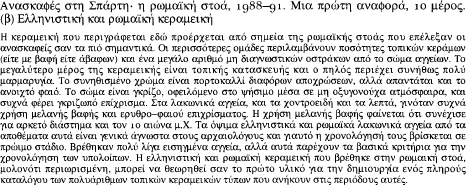Article contents
Excavations at Sparta: the Roman stoa, 1988–91 Preliminary report, part 1: (b) Hellenistic and Roman pottery
Published online by Cambridge University Press: 27 September 2013
Abstract
The pottery described comes from areas of the Roman stoa that were selected by the excavators as important. Most groups contained quantities of local tiles, glazed or unglazed, and large numbers of unidentifiable body sherds. The vast majority of the pottery was locally made and is micaceous, normally very micaceous. Its normal colour is orange of various shades, but it can be a light brown; fired in a reducing atmosphere the body is grey, and this can have a grey slip. There was considerable use of black glaze and red-to-brown slip on Laconian vessels, both coarse and fine; black glaze seems to have been in use at Sparta well into the 1st cent. AD. The generally late hellenistic and Roman Laconian vessels from these contexts are largely unknown archaeologically, and dating is thus at a preliminary stage. Very few imports were found, but these represent the main dating criteria. The hellenistic and Roman pottery found in the Roman stoa, limited as it is, can only be regarded as material for the beginning of a corpus of the many local forms of the period.

- Type
- Research Article
- Information
- Copyright
- Copyright © The Council, British School at Athens 1993
References
1 Special abbreviations:
Agora v = Robinson, H. S., Excavations at the Athenian Agora, v: Pottery of the Roman Period (Princeton, 1959) Atlante ii Google Scholar = Enciclopedia dell' arte antica: atlante delle forme ceramiche, ii (Rome, 1985)
2 Wace, A. J. B. and Dickins, G., BSA 13 (1906–7), 155–68.Google Scholar
3 Hobling, M. B., BSA 26 (1923–1925), 277–94.Google Scholar
4 Dawkins, AO 18; A. Delt. 29 (1973–4), B 2, pl. 187.
5 Meyer-Schlichtmann, C., Die pergamenische Sigillata aus der Stadtgrabung von Pergamon (Berlin, 1988), pl. 40. 53.Google Scholar
6 Cf. Hayes, J. W. in Atlante ii, pl. 14. 7.Google Scholar
7 Goudineau, C., La Céramique arétine lisse (Paris, 1968).Google Scholar
8 Slane, K. W., Corinth xviii: The Sanctuary of Demeter and Kore, 2: The Roman Pottery and Lamps (Princeton, 1990), 78.Google Scholar
9 Peacock, D. P. S. and Williams, D. F., Amphorae and the Roman Economy (London, 1986).Google Scholar
10 Sciallano, M. and Sibella, P., Amphores: comment les identifier? (Aix-en-Provence, 1991), p. [94].Google Scholar
11 Cf. Atlante ii, pl. 17. 7.
12 Cf. Atlante ii, pl. 11. 19.
13 Cf. Atlante ii, pl. 14. 7; Slane (n. 8), p. 50, no. 94.
14 Slane (n. 8), 50; Agora v, pl. 61, M 31 = Atlante ii, pl. 15. 15 (ESB form 80, c. AD 80–150).
15 Hochuli-Gysel, A., Kleinasiatische glasierte Reliefkeramik (Berne, 1977), pl. 64, I. 3.Google Scholar
16 Meyer-Schlichtmann (n. 5), pl. 13. 175.
17 Riley, J., Libya antiqua, 13–14 (1976–1977), 150.Google Scholar
18 Cf. Blonde, F., Greek Lamps from Thorikos (Gent, 1983), 118–19.Google Scholar
19 Bittel, K. (ed.), Pergamon: gesammelte Aufsätze (Berlin, 1972), 101, fig. 7.Google Scholar
20 Peacock and Williams (n. 9).
21 Rotroff, S. I., Agora xxii: Hellenistic Pottery: Athenian and Imported Moldmade Bowls (Princeton, 1982).Google Scholar
22 Cf. Mayet, F., Les Céramiques à parois fines dans la péninsule ibérique (Paris, 1975), form VI (pl. 11. 81).Google Scholar
23 Grace, V. R., Amphoras and the Ancient Wine Trade (Princeton, 1961 ), fig. 60, left.Google Scholar It comes from a context of the late 1st and the first half of the 2nd cent.: Agora v, pl. 19, M 54.
24 Empereur, J.-Y. and Picon, M., in Amphores romaines et histoire économique: dix ans de recherche (Rome, 1989), 230, fig. 5.Google Scholar
25 Sciallano and Sibella (n. 10), p. [96].
26 Desbat, A. and Picon, M., in Empereur, J.-Y. and Garlan, Y. (eds), Recherches sur les amphores grecques (Paris, 1986), 639, fig. 2. 10.Google Scholar
27 Loeschcke, S., AM 37 (1912), pl. 27. 1Google Scholar; Kenrick, P. M., Excavations at Sidi Khrebish, Benghazi (Berenice), iii. 1: The Fine Pottery (Tripoli, 1985), 258, fig. 47, B 363. 1Google Scholar; Hayes, J. W. in Atlante ii, pl. 16. 16.Google Scholar
28 Loeschcke (n. 27), pl. 27. 15; Hayes, in Atlante ii, pl. 17. 4.Google Scholar
29 Bittel (n. 19), 98, fig. 5.
30 BM GR 1854. 5–91. 7 and GR 1856. 8–26. 409.
31 Agora v, pl. 9, j 1.
32 Hayes, J. W., Late Roman Pottery (London, 1972), 64, fig. 11. 45. 2.Google Scholar
33 Cf. Hayes (n. 32), 92, fig. 14. 2.
34 Perlzweig, J., The Athenian Agora, vii: Lamps of the Roman Period (Princeton, 1961).Google Scholar
35 Slane (n. 8), 86, no. 182.
36 Perlzweig (n. 34), 51–2; Williams, H., Kenchreai, v: The Lamps (Leiden, 1981), 53.Google Scholar
- 2
- Cited by




